Click here to jump to the recipe
My younger daughter refuses to drink kombucha (referring to the SCOBY, “How can you put anything into your body that touched that!”). She won’t try sauerkraut (“What’s that smell?!”). She will eat sourdough, although somewhat reluctantly (“Why can’t we have a normal kitchen?”).
But she scarfs down this. If you want to get some good microbes into a picky eater, make salsa. They simply cannot resist it. The stuff tastes fantastic and is so easy to make. You basically cram a bunch of fresh ingredients into a jar and wait. As with everything I have ever fermented, when I first made salsa, I thought to myself, “That’s all I do?! How did I not already know about this?!”
Salsa stocked on store shelves has been pasteurized at a high temperatures in vinegar, killing all the microbes, bad and good, making it shelf-stable for years. Although salsa in the refrigerator section contains fresh vegetables, it lacks the probiotic, gut-loving goodness of the fermented stuff. And look at all that plastic! And the prices! For this post, I made a small vat of salsa, about 40 ounces (5 cups), for five dollars or so. If you can actually find fermented salsa at the grocery store or farmer’s market, it will cost a small fortune. Oh and fermented will keep for months in the refrigerator or cold cellar, if not longer, unless you eat it all quickly, which you may because it tastes so delicious.
And the taste! You cannot beat it. It has a natural tang, a slight effervescence and tastes intensely fresh. I can’t quite describe it. It just kind of makes your tongue sing. I suppose fermented salsa compared to processed salsa is similar to the difference between eating a home-grown tomato in July versus a store-bought one in winter imported 5000 miles from Chile.
Ingredients
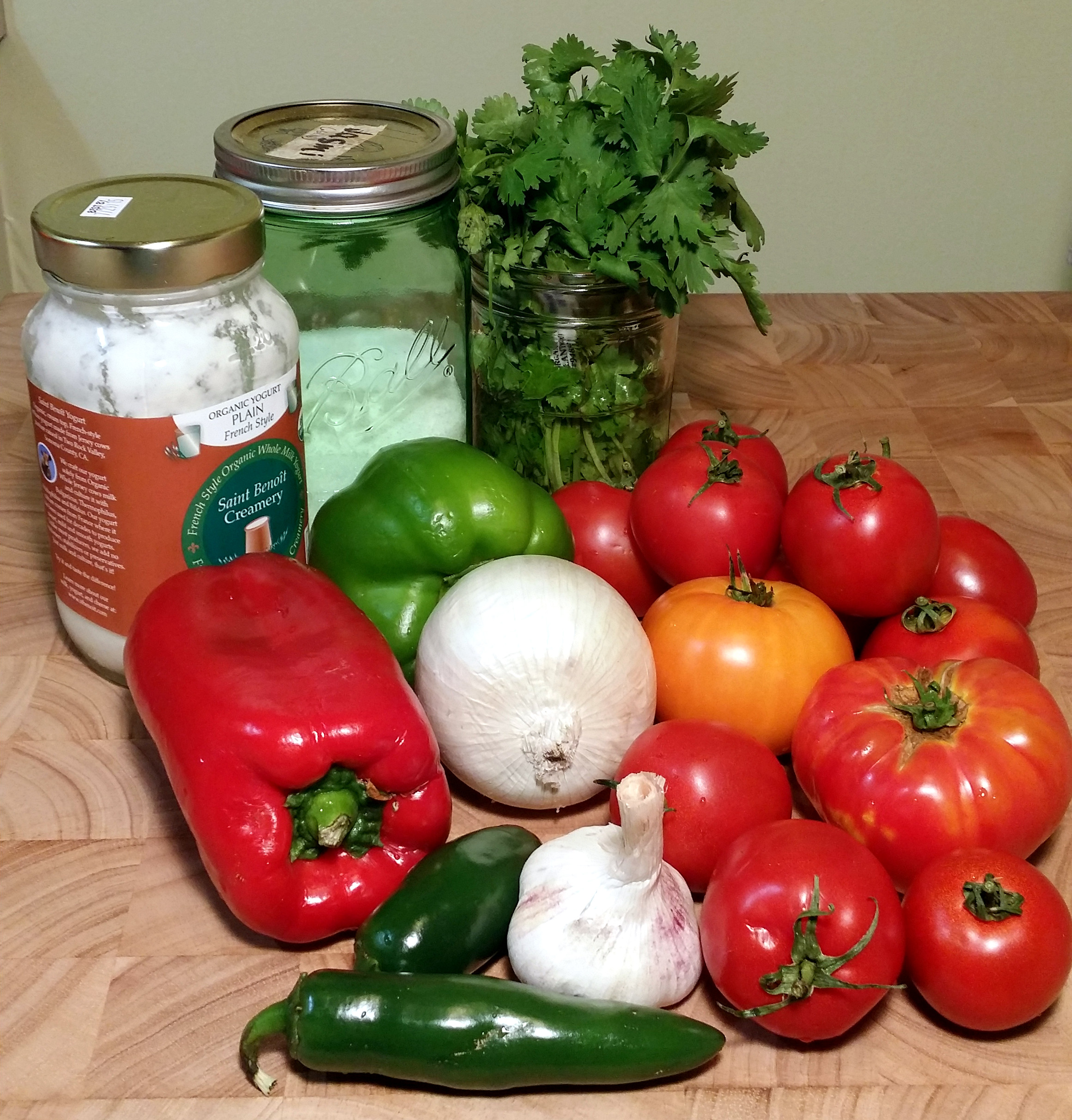
You can vary the amounts of these ingredients according to taste, however use plenty of tomatoes so you render the correct juicy consistency.
- 3 lbs tomatoes, cored and chopped into bite-size pieces
- 1 or 2 bell peppers, minced
- 1 white onion, minced
- 6 garlic cloves, minced
- 2 jalapeños, minced
- 1/4 cup cilantro, minced
- 2 to 3 tbsp fresh whey (optional)
- 1 tbsp salt, plus more to taste
- 3 to 4 tbsp fresh squeezed lime or lemon juice, or to taste
Directions
To speed things up, you can use a food processor, however DO NOT mince onions in there unless you like the VERY bitter taste the food processor will produce. Garlic can also taste bitter if processed this way. For the last batch of salsa I made, I put everything in the food processor except for the onions and garlic. For the salsa in this post, I chopped or minced everything by hand with a knife.
1. All vegetables are covered in naturally occurring lactic-acid bacteria. When you submerge the vegetables in liquid, these anaerobic bacteria will ferment your food. To kickstart my salsa, I add some microbe-filled whey strained from high quality plain yogurt. The fermentation will work without the whey; it may simply take a little longer.
If you add whey, before you begin chopping and mincing, strain some yogurt until you have collected a few tablespoons. If you make your own yogurt, you will render quite a bit of whey for kickstarting fermentations.
n.b. The vegetables will ferment without whey. They will just take a bit longer.
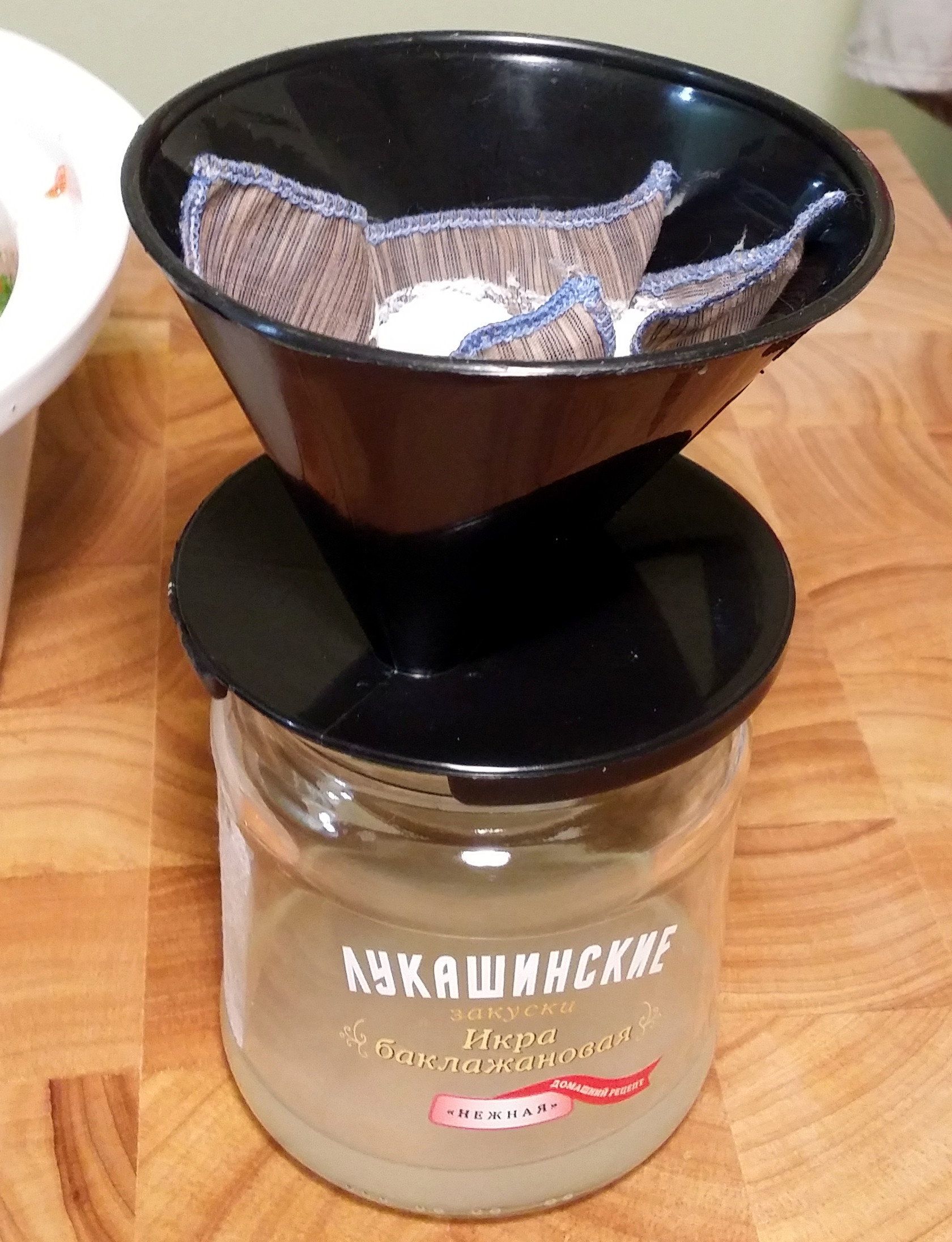
2. Place the bite-size tomato pieces in a bowl. Use your hands to crush them into a soupy consistency. This will take only a few minutes. You do not need to score, blanch and peel the tomatoes for this recipe (yay!).
3. Stir in the remaining ingredients, including the whey, if using.
4. Pack the salsa into clean jars and replace the lids and set aside at room temperature. Place the jars on a dish to prevent juice from oozing all over your counter when the salsa becomes lively and bubbly.
5. Burp your jars daily to release built-up carbon dioxide. You can stir the salsa every day while burping the jars to keep everything well mixed and prevent mold from forming on top. I haven’t had trouble with mold forming in jars of salsa, but I have had a bit form when fermenting tomatoes in an open crock. I just scrape it off (if it’s white). You may notice your vegetables separating from the liquid. Just stir everything up/shove it down with a clean spoon.

6. If you added whey, taste your salsa after it has fermented for two days. It should have a natural tang to it and a slight effervescence. It may take a couple of days longer to ferment without whey. If you like the flavor, place your jars in the refrigerator to slow down the fermentation. If you prefer your salsa more tangy (or if it’s not ready), let it ferment a little longer (12 to 24 hours).
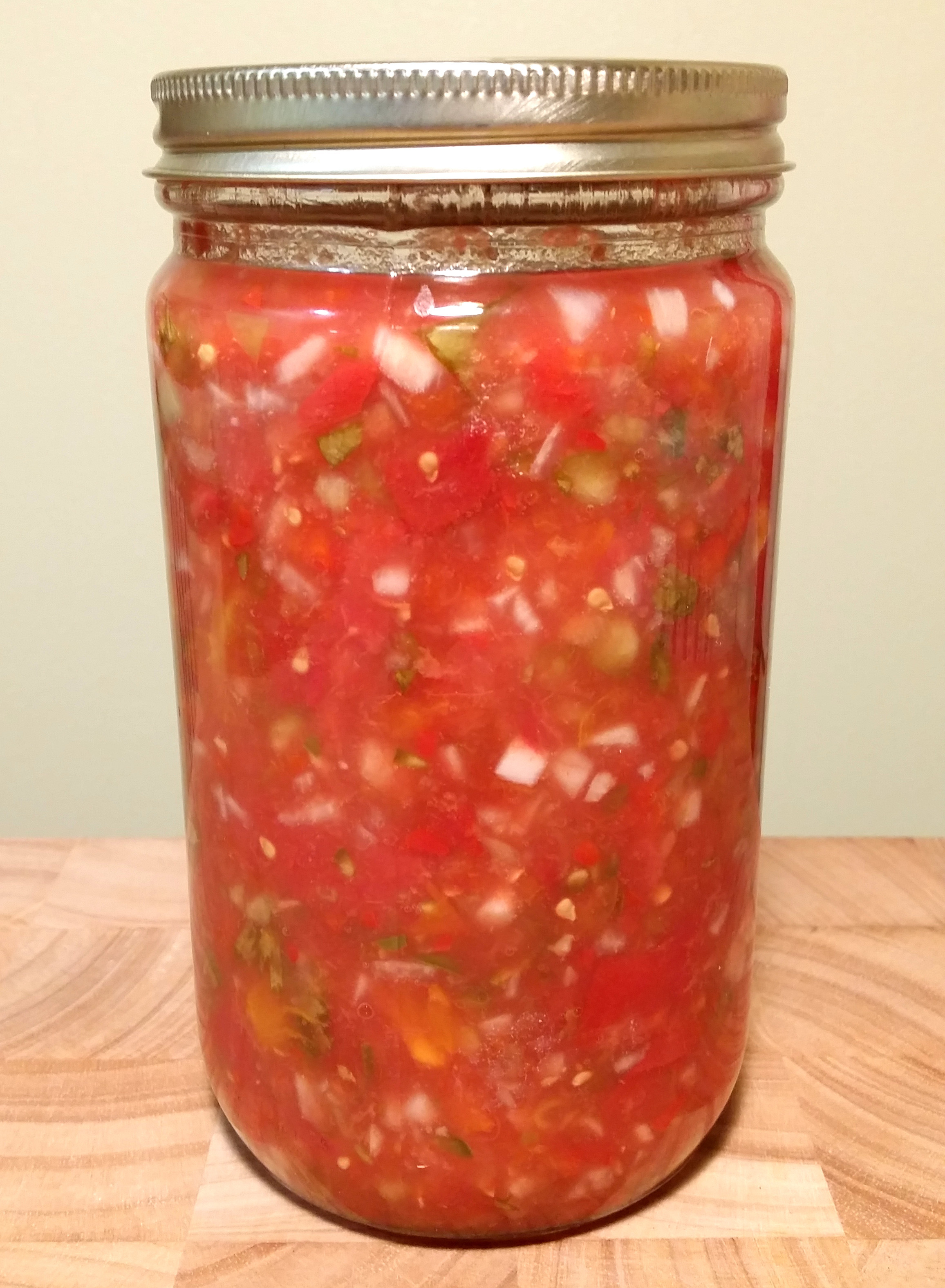
Fermented Salsa
Ingredients
- 3 lbs tomatoes, cored and chopped into bite-size pieces
- 1 or 2 bell peppers, minced
- 1 white onion, minced
- 6 garlic cloves, minced
- 2 jalapeños, minced
- 1/4 cup cilantro, minced
- 2 to 3 tbsp fresh whey (optional)
- 1 tbsp salt, plus more to taste
- 3 to 4 tbsp fresh squeezed lime or lemon juice, or to taste
Directions
1. If using whey, before you begin chopping and mincing, strain some yogurt until you have collected a few tablespoons.
2. Place the bite-size tomato pieces in a bowl. Use your hands to crush them into a soupy consistency. This will take only a few minutes.
3. Stir in the remaining ingredients, including the whey, if using.
4. Pack the salsa into clean jars and replace the lids and set aside at room temperature.
5. Burp your jars daily to release built-up carbon dioxide.
6. If you added whey, taste your salsa after it has fermented for two days. It may take a couple of days longer to ferment without whey. If you like the flavor, place your jars in the refrigerator to slow down the fermentation. If you prefer your salsa more tangy (or if it’s not ready yet), let it ferment a little longer (12 to 24 hours).


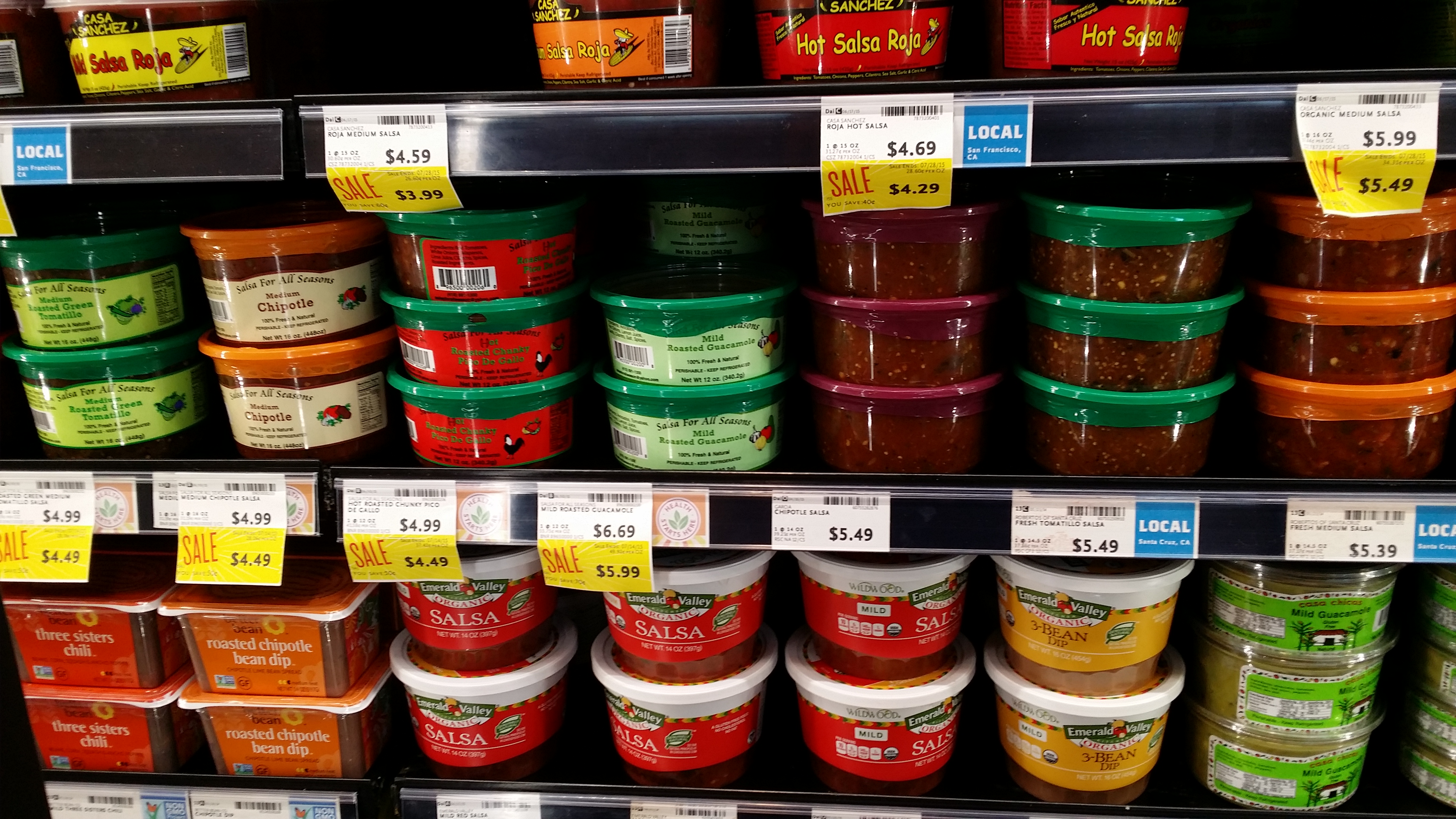

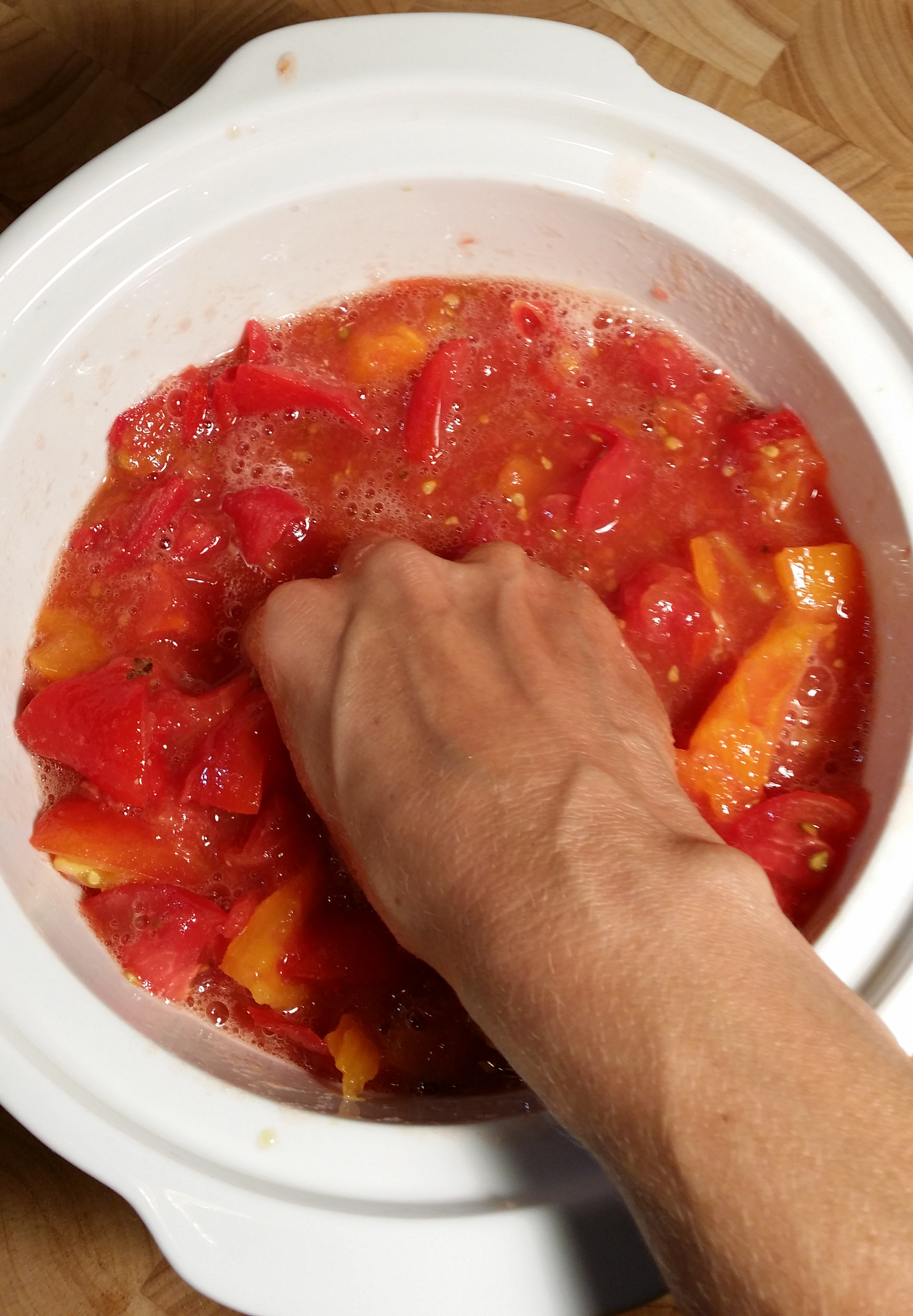


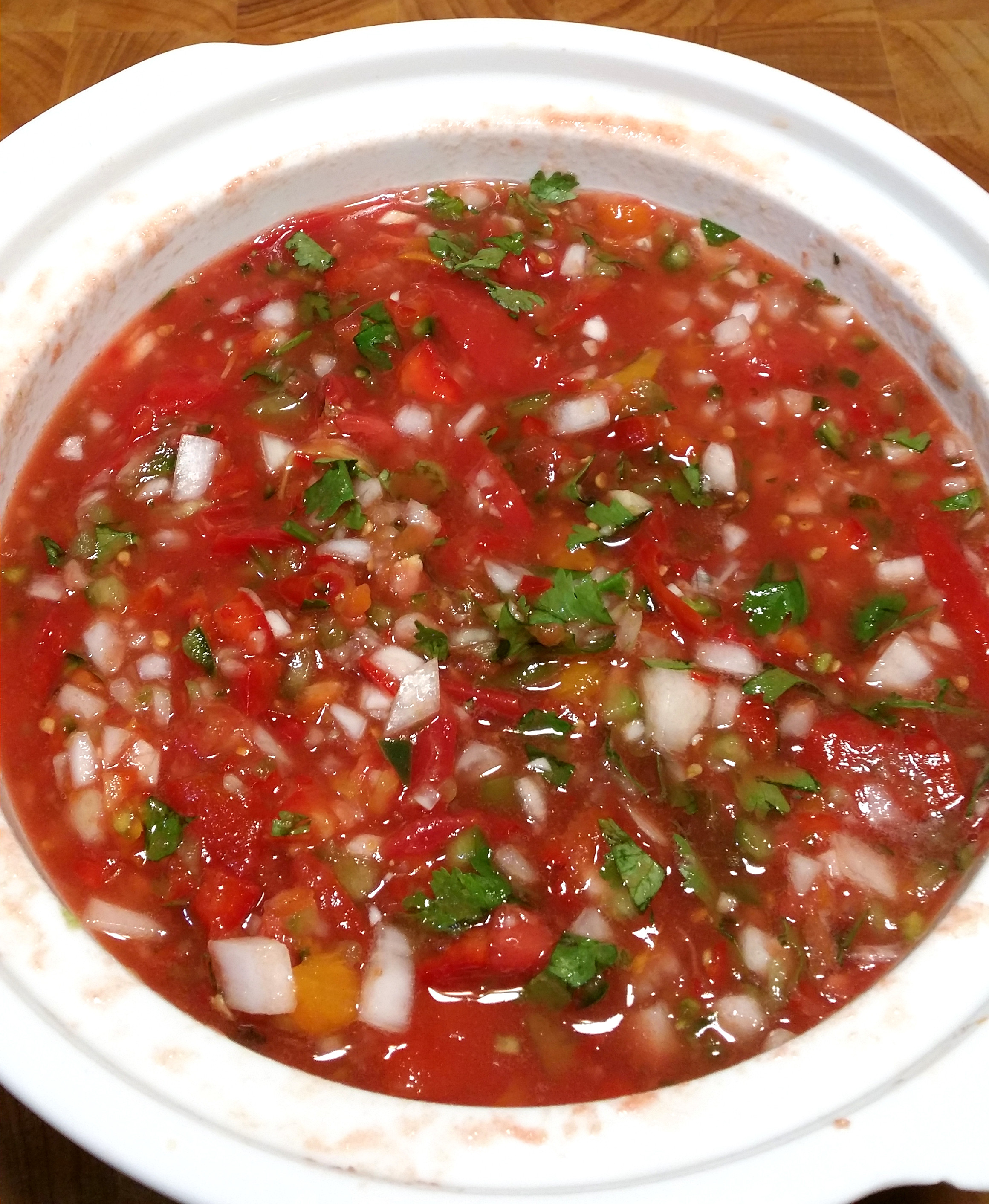
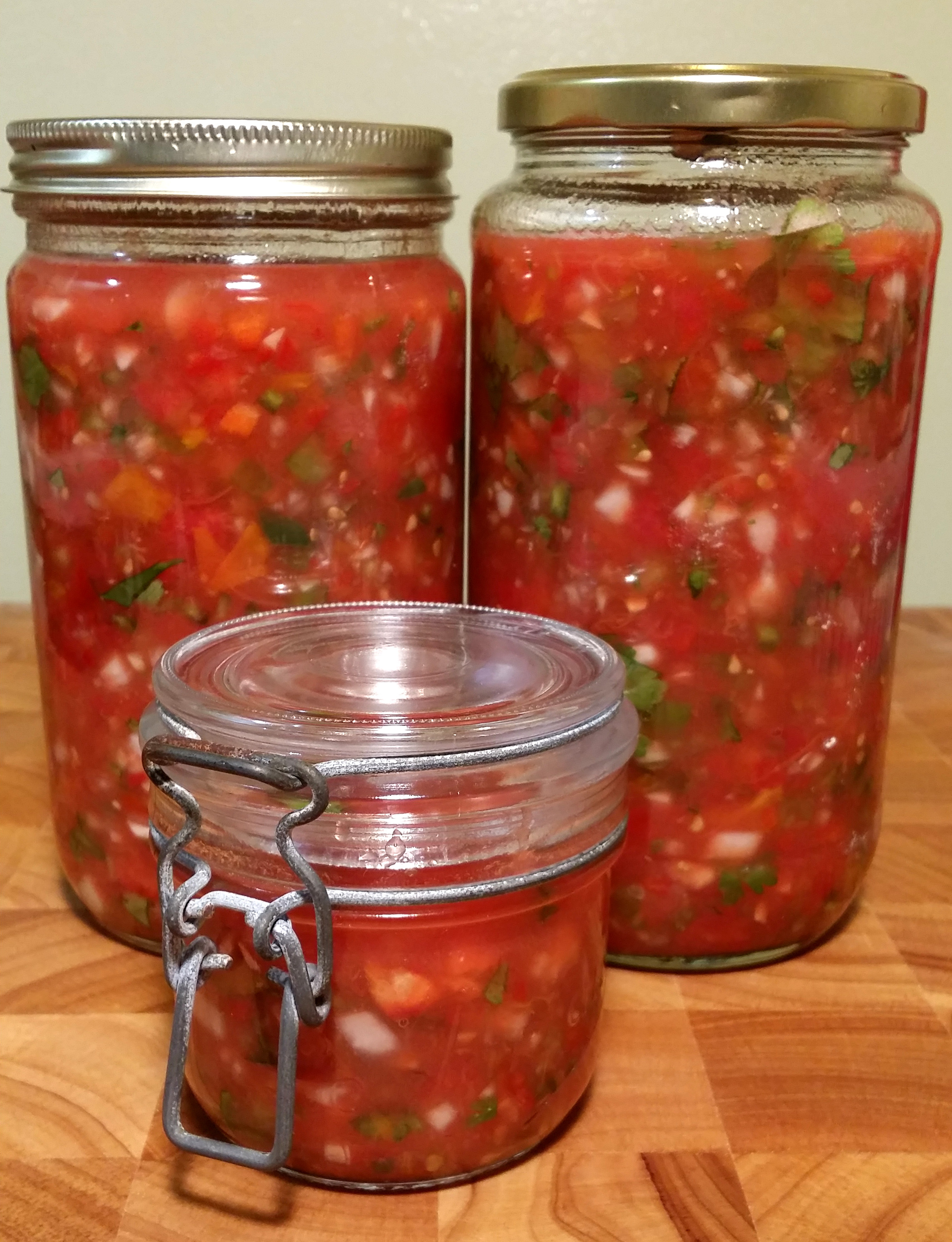
It is funny how picky kids like salsa. I even blend sauerkraut and its brine into mine. Yours looks so fresh and nice 🙂
Thanks Annie! I’m so happy I’ve found something my daughter will eat! Thanks for the tip about the sauerkraut and brine. That’s also great if you don’t have any whey!
Wonderful recipe, I think most of us have a picky eater in the house! How long do you think it will keep in the fridge?
Madeleine.x
Thanks Madeleine. I have some fermented tomatoes in the fridge from last September and they are still good. I think the salsa would last many months but I don’t know for sure because we eat it so quickly 😉
I’ve read – from sources I trust, including Sandor Katz – that whey should not be used in vegetable ferments.
:O Really? I put whey in my beet kvass and thought I had been loosely following Sandorkraut’s recipe, but I may have it mixed up with Sally Fallon’s. She definitely calls for whey. What’s the problem with it?
Basically, different bacteria types that aren’t always compatible. More on it here: http://phickle.com/why-i-dont-whey-lacto-fermentation-without-starters/
And here:
http://kitchenlib.com/basics/why-i-dont-use-whey-as-a-vegetable-fermentation-starter/
And here:
http://fermentacap.com/index.php?option=com_content&view=article&id=31&Itemid=170
Thanks for the links Becky. I will check them out.
Sandor says whey should not be used because the bacteria is different from the vegetable bacteria.. The whey is going to die within a week and be replaced by the proper vegetable bacteria.
So what can you do? Use a little juice from a ferment such as cabbage? Yes this could work if the cabbage is just starting out, since a 3 week old ferment doesn’t have the bacteria you want at the start of the cycle. You now have the same situation as the whey.
For me, I just add salt to adjust the phone and let Mother Nature do her thing. After the thousands of years she has gotten good at it.
It will work without anything to kickstart it. The lactic-acid bacteria will just go to town.
I agree I never use anything to jump start it either, and thought I posted so.
You did. I was agreeing with you.
Did I miss the program??? Eeeek!
>
Not at all Alice! I thought I should write the post before the webinar. People like to have something to refer back to later 🙂
I am fermenting my first batch of summer tomato salsa right now Anne Marie! It’s SOOO delicious and fresher than store bought. I put it on my morning eggs, veggies, and of course, mexican inspired dishes. YUM!
I somehow didn’t see this, Karen. Thanks for the ideas. I think I’ll have some on my eggs either for dinner tonight or breakfast tomorrow 🙂
The only change that I made to the recipe was to add a few tablespoons of yogurt instead of whey. I’m a lazy chef. 🙂 I am so excited about this recipe. I’ve wanted to make salsa for years, but didn’t feel like I could pull it off. Fermented salsa though is genius. Raw and fermented – super healthy and I will never have to purchase salsa again!! Thank you!
Will you please let me know how that works out with the yogurt? Thanks for checking out the post!
Day 2 and the spouse gave it a try. His eyes rolled back in search of heaven. I said it needed to ferment another day. He said, “To be more awesome? If that’s possible, Okay!!” We will put one jar in the fridge to slow fermentation and leave the other jar out one more night. The yogurt is working great though. 🙂
Great! I’m glad it’s working and that your husband likes it so much. Thanks for the update 🙂
totally not fair – it is freezing here coldest winter I have seen for a long time and the sight of tomatoes and salsa … roll on summer I say
I hope you’re keeping warm, Sandra and that it warms up soon. You’ll have to add fermented tomatoes to your awesome pantry in the summer 😉
[…] for toast with avocado. This morning I whipped up some breakfast burritos: sausage, scrambled eggs, salsa, and cheese. They went over pretty good–I’m going to experiment with breakfast pizza […]
I’m just reading about fermenting foods for the first time – this being the first recipe I’ve even looked at! – and I love how easy this recipe is. I’m looking to make more of these types of foods because we love to eat them, but my hubby ss to react to onion, and especially garlic; do you know, would this recipe still ferment okay if I omitted these two key ingredients? Thanks.
Oh sure, that would still work. I have fermented plain tomatoes. All vegetables and fruit and covered with the microbes that ferment the food (lactic acid bacteria). Oh and by the way, all the recipes are very easy. Sauerkraut is a good one to start with too.
I don’t understand the reasoning by placing it on the refrigerator so soon. There is three stages to fermenting, day three will stop it at the first or the beginning of stage 2. With most ferments 2 to 4 weeks is needed, or at least not before the bubbling slows down.
As for a starter I just use some brine from the pickles or kraut.
BTW my 4 month old garlic in the refrigerator still not ready, but the from same batch that’s been on the counter, the taste is out of the world. The brine is a good start for a great salad dressing.
I ferment my sauerkraut for a couple of months usually and it bubbles for less than a week (everyone’s kitchen is different however…). I find the salsa ferments really quickly and tastes great after a short time so I stop it early. Dill pickles also take only about five days or fewer. After that, they turn to mush (at least in my kitchen they do…). If you let your salsa go longer, please let me know how it goes. That garlic brine salad dressing sounds delicious 🙂
how much does this make? thanks
Hi Elijah. This makes about 6 or 7 cups of salsa. It’s quite a bit.
Will definitely try when tomatoes are back in season. So glad I found your blog. I am now a homemade sauerkraut addict and toying with the idea of making my own sourdough. Fermentation is a sneaky addiction, it just creeps up on you… And it’s all your doing! 😊 Just a question for the lazy: can you get your whey from the liquid that floats to the top of the yogurt i.e. without straining the yoghurt?
Hi Bernadette. I’m glad you found my blog too 🙂 You don’t have to add the yogurt. It will still ferment but a little bit slower, which should be fine because this ferments so quickly (a matter of days). But, yes, you can just use the whey at the top. My yogurt always has some of that at the top. ~ Anne Marie
Looks great! That’s for blogging this recipe and showing us amateurs how its done! I love salsa and the extra gut probiotics is a plus..
You’re welcome. Thanks for checking it out. I love the gut probiotics too. Such a delicious way to maintain your gut health. Enjoy!
[…] Fermented Salsa […]
I loved your recipe so much that I posted in my latest blog! Of course, I tagged you in it & gave you all the credit but I wanted to share it will you… Thanks again for the great recipe !! https://thehypothyroidismchick.com/2016/08/18/your-ultimate-guide-to-fermented-foods-for-hypothyroidism/
Thank you so much! That looks like a great post. People occasionally ask me about goitrogens in relation to fermented foods and I need to read up on them. Thanks for posting all that info 🙂
just out two jars of this down today, however the mixture looks pinkish and milky, maybe I added too much whey….I am hoping that milky colour will go away as its not really a salsa to me if it stays….
So funny. I saw that photo of the chopped vegetables and the bamboo cutting board (exactly like one I own) and thought for a teeny fraction of a second that it was one of my photos! We do so many things alike in the kitchen, you and I, or so it seems. We love pico de gallo so much that I don’t know that I could wait for fermentation. I’d probably nibble it all gone, a little here and a little there, but I will pin this so I can give it a try once the summer tomatoes start coming in. Looks delicious!
Great minds… Well, make extra then and over the days what’s left will ferment 😉
Sounds like a plan!
I am kind of new to fermenting, but not quite the novice. We make our own krauts with different flavors, pickles, pickled okra, yogurt and yogurt cheese and kombucha all from scratch. However, I have a question about this recipe.
Why is there no salt? I understand the whey begins the fermentation process, but I thought the salt was to allow the lactobacillus reproduction while discouraging other harmful bacterias. Is the reason due to the acidity of the tomatoes, like why you can water bath can tomatoes instead of pressure can?
Thanks for the recipe, I’ll be sure to try it, and I look forward to your response.
I do add salt. It’s listed in the ingredients but I didn’t show it in the pictures for some reason (just the top one and I forgot the lemon/lime in that one…). Sorry for the confusion. I haven’t fermented vegetables without salt. I have read it can be done but is a bit tricky. Most importantly, I like the taste 😉
Oh, I totally missed it in the ingredients. I looked for it but it slipped right past me. Thanks! We are trying tonight. I’ll post an update next week!
Oh, I totally missed it in the ingredients. I looked for it but it slipped right past me. Thanks! We are trying tonight. I’ll post an update next week!
Yum! Thanks for the recipe. I must try this..
I still have some I made last fall and it looks and tastes OK. Any problem or danger in eating? It was shoved to the back of my fridge. Need to clean it out more often!
It should be fine. Fermented foods last for many months, even a year or more. If it looks and smells fine it should be okay. I’ve eaten fermented salsa that was nearly a year old and survived 😉
Will Kefir Whey work?
I would think so with all those microbes teeming in it. You can also just leave out the whey. It will still ferment but just a little bit slower.
I used nothing to kick start it and in three days it was bubbling away on the counter
This looks really interesting–and easy. I’ll try it this summer! This may be a dumb question, but what do you mean by “burp” the jars? Thanks!
Hi Rhea. It is very easy! That’s not at all a dumb question. To burp the jars, simply open and close them quickly. That will release the carbon dioxide building up in there. Enjoy! ~ Anne Marie
[…] was at a completely different scale than I was looking for. Thankfully, I was able to find great guidance online from Zero Waste […]
Fermented salsa is fantastic! Thanks for the recipe
My pleasure. The stuff is addictive. Good thing it’s so healthy 😉
I recently made a pineapple cucumber salsa which I fermented, lots of peppers both hot and sweet, it was a big hit with the family
:O No wonder! That sounds delicious, refreshing and fabulous! I bet it didn’t last long. I would gobble that up.
How important is it to keep all of the veggies submerged like in other ferments? I feel like with veggies chopped so small they would float at the top.
Hi Greta, I find the veggies do float to the top but they don’t get mushy or moldy. The whole concoction is so wet, maybe they are submerged enough. You could put something in there to weigh them down if you’re worried about it. But I haven’t had a problem. ~ Anne Marie
When does the salsa start to bubble? It’s been 24 hours, and I haven’t noticed anything yet.
That would depend on the temperature. Cooler air or more salt will slow things down. I would expect to see bubbles by the second day if it is 7c. Or 45f. Otherwise I would expect 24 to 30 hours max.
I’m also not using any starter.
Thanks for your blog- it’s so inspiring! Do you store your salsa in the fridge or can it stay in the pantry? I’d like to be able to make a bunch and store it for the winter (of this and chutneys), but don’t want to go through the hassle (and maybe good-bacteria-killing temps) of canning.
Hi Angeline, I’m just noticing a pile of comments on my blog now… If you have a cold cellar, you could store salsa there. Otherwise, I would store it in the refrigerator. It will continue to ferment, but very slowly. At room temperature, it will ferment much more quickly and may go too far. I am with you on the canning. That will kill all the beneficial microbes. ~ Anne Marie
Presumably it’s OK to add chillies to spice it up a little? Also I live in a very hot country (47 degrees c today), should I leave it out of the fridge for the fermentation for less time? Thanks
Hi Sarah, Absolutely it’s okay! Add them to taste. OMG 47C. Yes, it will probably ferment quickly. Just keep an eye on it. You won’t ruin it keeping it out for the full two days, but why wait to eat it if it’s ready early 😉 ~ Anne Marie
I made this over the weekend and it taste fizzy/carbonated (?). Is that just the fermentation? I assume it’s still safe to eat?
Thank you.
Hi Chuck, Yes that’s normal. It’s a little bit effervescent. Those are the microbes releasing carbon dioxide as they eat the sugars in the food. It’s safe to eat. Enjoy! ~ Anne Marie
Thank for this recipe. I made some and it was awesome!!
Can I use tomatoes from my garden that I have peeled and frozen?
Can I use tomatoes from my garden that I have peeled and put into freezer?
Yes that will work! I have fermented stuff that I had frozen. Enjoy!
Hello from Brazil!
Can I use ginger bugs instead of whey?
Hello! Yes you could do that. I have used my ginger bug to make fermented chutney, which is the same process. I would add it in small amounts and taste as you go. This will also ferment without any starter at all. Enjoy! ~ Anne Marie
Can I add little sweetner like honey or sugar to have a sweet and saur flavour? Or will it affect the fermentation?
Hi Ambily,
Yes you can add that. The microbes will gobble it up 🙂
~ Anne Marie
I strained some of my homemade yogurt though a loose cloth (maybe too loose since it had a slight milky color instead of being mainly clear). Maybe I wasn’t supposed add it to based on the comment above about adding whey or that some yogurt was also added. We also only have iodized salt so I added that, but we added just a bit less than 1 tablespoon since my husband didn’t want it salty. Half of the tomatoes were from the farmers market a week and a half ago, and the other half were not organic store tomatoes.
Anyway, tonight (two nights later) I opened the jars on my counter and they smell awful. We tasted it the night we made it and it was the most lovely pico de gallo tasting salsa, but now they have a strong (moldy?) smell. I even tasted one and it tastes terrible. I think I will have to throw all of them. I added a lot more salt now and put them in the fridge, but I am pretty sure I can not save them now. I’m not sure what fermented salsa is even supposed to taste like. Kimchi? Sauerkraut? Mine does not taste at all like that at all. I feel like a failure! I want to love fermenting as much as you do! Definitely cutting down on the salt was a bad idea. Since yogurt is dairy based, I also think I should have just left them on the counter without trying to add whey as well.
Is there a way to make this with thick, chunky salsa? I love salsa but I’m not a big fan of it with a runny/soupy consistency.
I made this this week, and the resulting brine/liquid ended up being slimy. Did I do something wrong? I opted to not use whey. Thanks!
Hi Katie,
I’ve had this happen with sauerkraut. A strain of unwanted bacteria gets in there and makes the vegetables slimy. I would move the salsa to the refrigerator for a few weeks. If you let the jars sit, the bacteria should sort itself out. If it’s very hot where you are and you try this again, you could add a starter culture. That might also help. If you’re vegan and don’t want to use whey, you could use a bit of juice left over from another ferment like sauerkraut if you have any or a ginger bug. But for now, I’d just set this batch of salsa aside.
~ Anne Marie
[…] ou salsa fermentada sem gengibre ou malaguetas para que o pão não fique picante 🔥. O líquido desta salsa fermentada feita com pêssego e sem malaguetas funciona também […]
I absolutely LOVED this salsa. I let it ferment for about 3 days and ate most of it right away. The leftovers kept fermenting in my fridge where I let it sit for a bit over a week. It got really fizzy and I wasn’t a fan of eating carbonated salsa, so I just threw it in a pot where I cooked it with some tinned tomatoes, which made for a tasty sauce.
The salsa tastes great but it separated with a lot of liquid (about 3 inches) at the bottom of the jar and the solids at the top. Is this normal?
Hi Jane,
Yes that’s normal. Sounds like it’s ready! I would stir it up, taste it and put it in the refrigerator.
~ Anne Marie
Hi there. I don’t have that much liquid…do I need to add water to cover the top of the ingredients?
Yes, just pour in a little bit to cover the ingredients. If you need a huge amount, you’ll need to add salt also, but I can’t imagine you’ll need more than a few tablespoons of water.
[…] “Água” de Chucrute caseiro ou “Água” da Fermentação de Picles ou Água desta salsa fermentada feita com ananás e sem malaguetas = […]
Hi Anne Marie,
I whipped some of this up yesterday morning, but noticed today that some of the salsa wasn’t covered by fluid. In a few fermenting books I’ve been reading, they state that I should keep all veggies etc under the fluid. Should I toss this batch and make a new one with a weight to hold all the solids down?
Thanks,
Susan
Hi Susan,
I would add a bit of water to it if vegetables are poking out through the liquid on top. You can put a weight in the top also. If the vegetables look okay, they should be fine. They can turn brown when exposed to air (or moldy but you would notice that immediately), in which case you would scrape off the top layer and compost it. I hope that helps.
~ Anne Marie
Hello! I made the salsa a few weeks ago and it is super tasty but a bit too bubbly for me. Is there a way to reduce this for this batch or for future batches?
Second year making this and I absolutely love it. The last double batch I made late September 2021 and finally finished the last of it in July 2022. Still tasted great, but the veg were softer. I tried to make it last as looooong as possible!